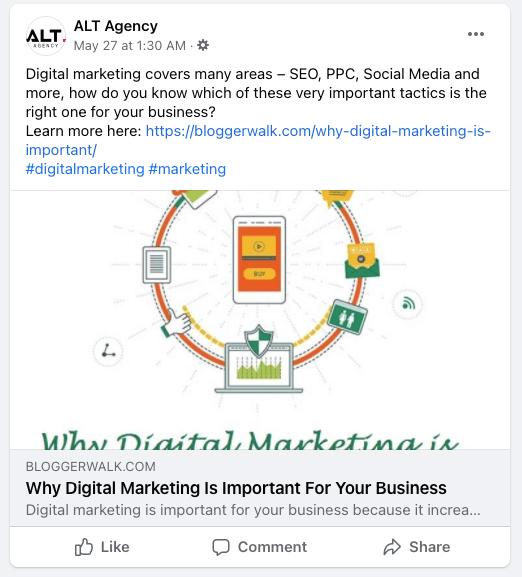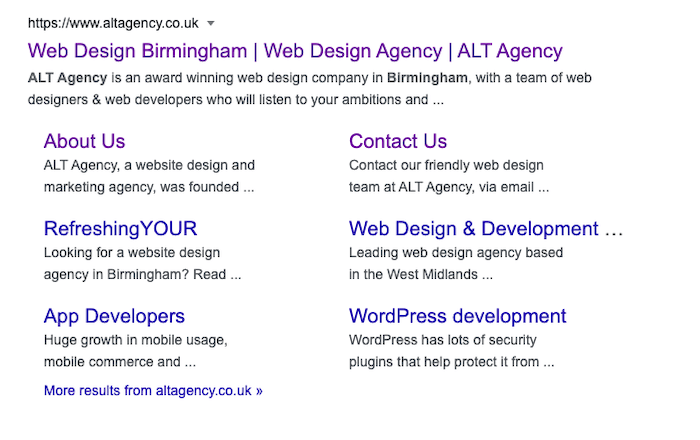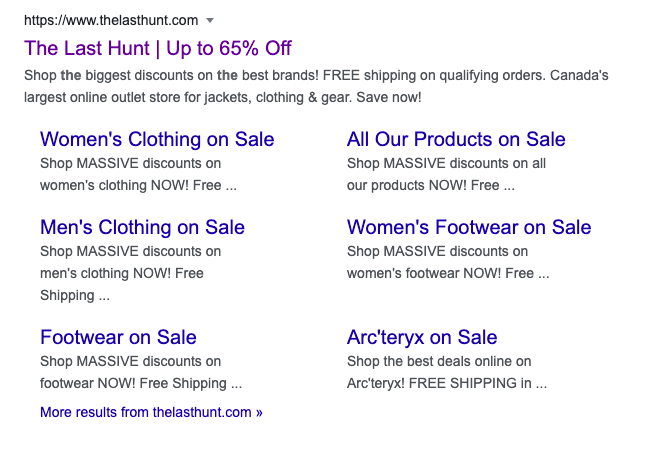
5th April 2022

Writing good meta descriptions is one of those quick SEO wins that can make a huge impact on your conversion rates.
By engaging users in search engine results, you can improve your click-through rates, website traffic, and increase opportunities for conversions.
In this guide, we’ll teach you everything you need to know about writing high-performing meta descriptions that convert.
Looking for additional SEO services in Birmingham? Browse our SEO services and reach out when you’re ready to improve your organic traffic.
Interested in learning more SEO tips and tricks? Check out our latest range of SEO guides:
Meta descriptions are short summaries of a website or webpage that show up on the search engine results page (SERP) or on social sites when a piece of content is shared.
Meta descriptions introduce a user to your webpage and give them a short description of what they can expect once they click on your site.

Correct use of meta descriptions is an important SEO factor that can boost website conversion rates by encouraging clicks on the SERP.
Improper use of meta descriptions can lead to users being confused about what content they will find on your site, resulting in them visiting a competitor’s site instead.
If your goal is to build a user-friendly website that attracts new customers, shows up in search, and encourages clicks or conversions, meta descriptions should be an important part of your ongoing strategy.
Meta descriptions give search users a small intro to the content that will be on your website or webpage. This helps a user decide whether or not to click on your page.
Well-optimised meta descriptions should also contain keywords that offer another potential search ranking factor for your website. By integrating relevant keywords in your meta descriptions, your website has the chance to turn up higher in search engine results.

If you want to optimise your website for SEO voice search, you need to pay attention to your meta descriptions. Write meta descriptions that are the right length and contain relevant keywords so that searchers can easily understand the content of your site.
Meta descriptions are also important for social media sharing, as they become the short snippets that accompany any linked content.
In the below example, you can see how the meta description is previewed at the bottom of the post.

Officially, Google says that meta descriptions are not used in their ranking algorithm. That statement aside, meta descriptions do impact click-through rates (CTR) and SERP rankings, so they do have an influence on SEO.

More than SEO title tags or URLs. In fact, meta descriptions often take up 50% of the available space in a search result, so it’s important that you grab your user’s attention within this space.

If relevant keywords are present in your meta description, Google will bold them to highlight to the searcher that they have found a piece of content that matches their search. You can see this in the above example, where ALT Agency is bolded.
By showing users that a search is relevant to their query, you increase the likelihood that they will click on your link.
According to Backlinko’s top Google ranking factors, pages that get clicked more turn up higher in the SERP.
Ultimately, crafting optimised meta descriptions can help you get higher SEO rankings and boost your organic SEO traffic by encouraging users to visit your site.
Meta descriptions are displayed in search as short snippets below a URL and SEO title.
Search engines like Google will often pull meta descriptions from your website content. This can happen whether or not you’ve written them yourself.

You can see an example of this in the following image.

Google says it will rewrite meta descriptions if:
According to Ahrefs, 61% of web pages have meta descriptions that are truncated. While that may seem like an issue, their data also uncovered that Google is slightly less likely to rewrite meta descriptions that are truncated. This means that keeping your meta descriptions within the right word lengths may not save you from having them re-written.

We’ve answered some of the most common questions around meta tags below.
Covering everything from what to write n a meta tag right through to which pages need a meta tag. Read on below to see the most common meta tag FAQs.

There is no real meta description character limit but Google will usually truncate descriptions at around 155-160 characters.
An optimised meta description character length should be long enough to give a user a sufficient summary of the page, but not too long that most of the information is cut off on the SERP.
Moz recommends that meta description character limits be between 50-160 characters for optimal ranking.

If you’re worried about how your meta descriptions will show up in search, you can use a meta description length checker to guide you.
Here are a few meta description length checkers to use:
As SEO becomes more complicated, and the internet becomes more saturated, it can be difficult to know how to rise above the competition.
Part of running a high-converting website is continuously testing and optimising your content. This includes SEO tactics such as meta titles, meta descriptions, and URLs.
If you want to get the most out of your meta descriptions and turn up in more relevant search results, follow these five steps to writing high-performing meta descriptions.

1. Write Copy That Encourages Clicks
The main point of a meta description is to encourage search users to visit your website.
If you want to encourage clicks, you need to appeal to the needs of your users and offer immediate value for their patronage.
For example, if you want to drive traffic to your online store, you could use copy that talks about a sale you’re having or offer a discount for new users. Or, you could speak to your unique value proposition and social proof, like in the HelloFresh example below.

It’s also good practice to use calls-to-action within your meta descriptions in order to direct users towards your desired goal.
For example, if you want users to download your software, you can offer your free trial or another value offer within your meta description. You can see an example of this below.

2. Make Sure Your Description Matches the Content of Your Webpage
While old SEO hacks would tell you to stuff your meta description full of keywords to improve your ranking, that won’t work in today’s modern internet.
If your meta description doesn’t match the content of your web page, you’ll lose user trust. Not to mention, if too many users visit your page and leave immediately, your bounce rate will be impacted. A negative bounce rate can lead to negative SEO.
3. Watch Out for Duplicate Meta Descriptions
If you have multiple web pages with similar content, you may be tempted to duplicate your meta descriptions on more than one page.
Duplicate meta descriptions should be avoided, as they can negatively affect your search engine optimisation (SEO) and deter users from clicking through to your site.
If a user sees the same phrase repeated over and over in multiple descriptions, there is no incentive to click on multiple pages or view different content types.
The below example from the online outlet store The Last Hunt uses the same meta description on every page. While promoting a sale or discount is a great way to encourage clicks, the overuse of this deal reads as lazy and uninteresting.

4. Use Keywords in Your Meta Descriptions
Keywords are an essential part of writing meta descriptions because they offer search engines terms with which to relate your content.
For example, if we want to rank for “SEO Agency Birmingham” on Google SERPs, then we need to be using that keyword in our meta descriptions. That way, when a potential client searches for SEO services in Birmingham, our result will show up on their results page.
Just as you optimise images for your website with keywords, you should be optimising your meta descriptions with keywords to improve organic search.
Finding the right keywords for your brand may take a bit of research and testing. Be sure to continuously optimise your keywords to stay relevant in customer search.
5. Make Sure Your Meta Description is the Right Length
As discussed in previous sections, the optimal length for a meta description is under 160 characters.
Meta descriptions that exceed the recommended length will end up truncated and will not be able to display key information to searchers.
Meta descriptions that are too short will likely be rewritten by Google. This means you won’t be in charge of how your website is displayed in search engines, which can lead to a lot of lost website visitors.
Let’s imagine you’ve created the perfect landing page and you’re ready to drive traffic to your website.
You’ve crafted a catchy title tag, attached alt text to your images, and even put some budget behind Google Search Ads to improve your chances of being seen.

Rather than scrambling to whip up a catchy meta description that includes all of our aforementioned tips, check out these examples of great meta descriptions to guide you.

This meta description from TKMaxx uses the tried and tested marketing tactic “appeal to emotion”.
Right off the bat, they hook you in by describing how great you’ll look in their clothes. They follow this up with a hint of their offerings and close the clear with the promise of a bargain. All of this is done in line with the recommended character length, leaving their meta description un-truncated and clear.
Gousto Gets It Right With Cleverly Placed CTAs

This meta description from Gousto starts off by describing its unique value proposition, followed by the social proof of “award-winning”. They then offer the value of convenience, delivering 7 days a week, and end with a clear CTA, “Get started now!” Further linked CTAs are included in the blue hyperlinks, offering searchers more ways to browse the brand’s offerings.
Contrary to some SEO myths, meta descriptions are still important in today’s world of SEO.
With these tips and tricks to guide you, you’re ready to take the world of search by storm.

If you’re interested in more SEO tips and tricks, check out our latest range of SEO guides:
1. What is SEO and how does it work? A complete guide to successful SEO
2. SEO Title Tags (A Guide to Writing Successful Title Tags)
Looking for an SEO expert in Birmingham? Contact us to find out how you can improve your organic website traffic and increase your conversions.
Image credits:
Designed by macrovector / Freepik
Designed by macrovector_official / Freepik
Director of ALT Agency with a passion for all things design & conversion driven. Love Formula 1, Business and Property Investing.
Now we’d like to hear yours:
Do you have a big idea that you want to bring to the market quickly via a beautiful and user-friendly website? Whether you have the details of a project ready to go or need help finishing an existing project or even starting one from scratch, our team will help you achieve the results you need to make your business profitable.
Get In Touch Today